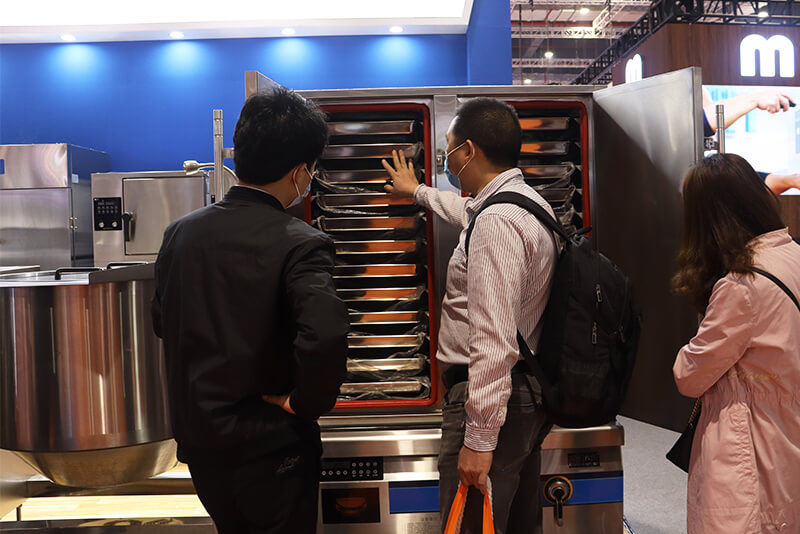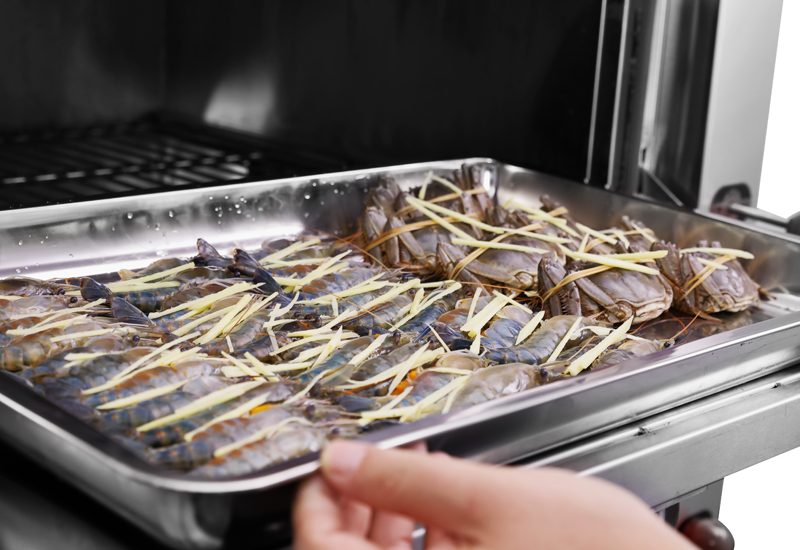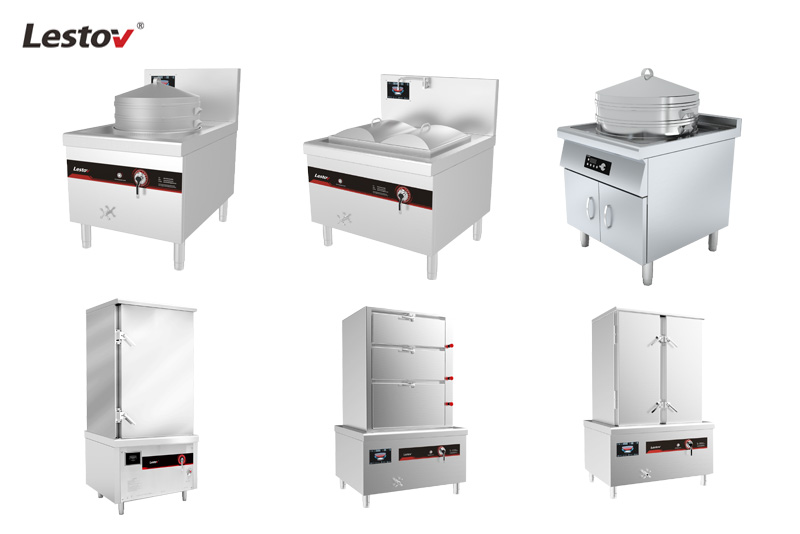In modern commercial kitchens, commercial induction rice steamers are becoming a new favorite in the catering…

Commercial Food Steamers: Guide to Purchase, Use and Maintenance – Lestov Manufacturer
In modern commercial kitchens, food steamers have become indispensable cooking equipment. With the continuous advancement of technology and increasing market demand diversification, different types of commercial induction steamers, gas steamers, electric steamers, and other products have emerged. However, faced with so many choices, choosing the steamer that best suits kitchen needs, using it to steam delicious dishes, and performing effective maintenance have become the focus of many catering practitioners.
This article will deeply analyze these ordinary commercial food steamers and conduct a comparative analysis from multiple dimensions such as working principle, performance characteristics, safety, energy saving, and environmental protection. Through reading this article, readers will have a comprehensive and in-depth understanding of commercial food steamers to make wise decisions and improve kitchen operation efficiency and food quality.
I. Comparison of commercial induction steamers, gas steamers, and electric steamers
1. Commercial induction steamers
(1) Heating principle and efficiency
Commercial induction steamers use the principle of electromagnetic induction to generate a low-frequency alternating magnetic field through the coil disk under the action of the control circuit so that the magnetic conductive pot generates a large number of dense eddy currents, converting electrical energy into thermal energy. Its thermal efficiency is as high as over 90%, and it heats up quickly. It can generate a large amount of steam in a short time, significantly shortening the steaming time.
(2) Safety
It has multiple safety protections, such as no pot detection, over-temperature protection, automatic fault detection, over-voltage and under-voltage protection, and phase loss protection. At the same time, since there is no open flame, there is no gas leakage or fire hazard, making it safer and more reliable to use.
(3) Energy saving and environmental protection
No exhaust gas emissions, no noise pollution, and significantly improve the kitchen environment. Compared with gas steamers, it can save more than 50% of energy and effectively reduce operating costs.
(4) Accurate temperature control
It can accurately control the cooking temperature, which can not only ensure the deliciousness of food but also promote the standard of Chinese food preparation.
(5) Easy to clean
There are no fuel residues and exhaust gas pollution, and the pots and stoves are easy to clean, with low maintenance costs.
2. Gas steamer
(1) Heating principle and efficiency
Gas steamer generates heat by burning gas. Its thermal efficiency is lower than that of the electromagnetic steamer, generally around 60%-70%. Its heating speed is slow, and it takes a long time to reach the same temperature.
(2) Safety
There is a risk of gas leakage and open flame combustion. It is necessary to be equipped with a complete gas leakage alarm device and fire extinguishing equipment, and the safety protection requirements are high.
(3) Environmental protection
A certain amount of exhaust gas, such as carbon dioxide and carbon monoxide, will be generated during the combustion process, which has a particular impact on the kitchen environment and air quality.
(4) Cost
Gas prices fluctuate wildly, and the operating cost is relatively unstable. In addition, the equipment itself needs to be regularly inspected and maintained for gas pipelines, which increases maintenance costs.
3. Electric steamer
(1) Heating principle and efficiency
It uses traditional electric heating elements, such as electric heating tubes and electric heating wires, to convert electrical energy into thermal energy. The thermal efficiency is generally between 70% and 80%, which is lower than that of an induction steamer.
(2) Safety
The surface temperature of the electric heating element is high during the heating process, which poses a risk of scalding. In addition, the overall power consumption of the equipment is relatively high, and long-term use may increase the circuit load, posing specific safety hazards.
(3) Environmental protection
Like an induction steamer, there is no exhaust gas emission, but the aging of the heating element will produce odor, affecting the air quality in the kitchen.
(4) Cost
The power consumption is high and the operating cost is high. In addition, the life of the electric heating element is relatively short and needs to be replaced regularly, which increases the equipment maintenance cost.

II. Factors to consider when purchasing a food steamer
1. Power and capacity
(1) Power
Choose the appropriate power according to the actual needs and frequency of use of the commercial kitchen. Generally speaking, the greater the power, the faster the heating speed and the higher the steaming efficiency. For example, for large restaurants or hotels, you can choose a commercial induction steamer with a power of 18kW or above to meet the significant steaming needs during peak hours.
(2) Capacity
Determine the capacity of the steamer based on the restaurant’s customer flow and dish demand for each meal. Too small a capacity will affect the speed of serving food, while too large a capacity may lead to a waste of resources. Ordinary commercial induction steamers have a variety of capacities, such as single-layer and double-layer, which can be selected according to actual needs.
2. Safety
(1) Protection function
Check whether the steamer has multiple safety protection measures, such as no pot detection, over-temperature protection, automatic fault detection, over-voltage and under-voltage, and phase loss protection. These functions can automatically cut off the power supply in abnormal situations to effectively prevent accidents.
(2) Material and structure
Choose a steamer made of high-quality stainless steel, which has better high-temperature resistance and corrosion resistance and longer service life. At the same time, check whether the structural design of the equipment is reasonable, such as whether the water tank, steam generator, and other components are easy to clean and maintain, to avoid sanitary dead corners or safety hazards caused by complex structures.
(3) Degree of intelligence
- Easy to operate
Modern commercial electromagnetic steamers mostly use microcomputer control systems, with intuitive operation interfaces and easy to use. They have functions such as preset programs and timing control, which can realize automatic steaming and improve work efficiency. For example, some high-end electromagnetic steamers support 99-minute timing control, which allows chefs to control the steaming time accurately.
- Intelligent adjustment
Steamers with intelligent firepower adjustment and constant temperature control functions can automatically adjust power and temperature according to different ingredients and cooking needs to ensure that the steamed food has a consistent taste and good quality. For example, functions such as five-speed firepower cycle adjustment and balanced power output can enable the steamer to maintain stable performance during long-term use.
(4) Brand and after-sales service
- Brand reputation
Choosing commercial induction steamers produced by well-known brands will ensure better product quality and performance. For example, brands such as Ilipu and Mingchu Magnet have a high reputation and good reputation in the field of commercial kitchenware, and their products have undergone strict quality testing and market verification.
- After-sales service
Understand the brand’s after-sales service system, including warranty period, repair response time, spare parts supply, etc. Perfect after-sales service can ensure that the equipment can be repaired in time when a failure occurs, reduce downtime, and ensure the regular operation of the restaurant.
III. How to steam delicious food
1. Pretreatment of ingredients
(1) Cleaning and cutting
Thoroughly clean the ingredients and remove impurities and dirt on the surface. According to the requirements of the dish, cut the ingredients into appropriate shapes and sizes, such as blocks, slices, and shreds. For example, when steaming vegetables, they can be cut into thin slices or strips to better heat and taste.
(2) Marinating and seasoning
Marinade and season the ingredients according to the taste of the dish. The marinating time should be determined according to the type of ingredients and the requirements of the dish, generally 15-30 minutes. Commonly used seasonings include salt, soy sauce, cooking wine, minced ginger and garlic, chopped green onions, etc., which can enhance the flavor of the ingredients.
2. Heat and time control
(1) Heat selection
Choose the appropriate heat according to the characteristics of the ingredients and cooking needs. For ingredients with a more complex texture or more extensive volume, such as potatoes and carrots, medium-high heat can be used for long-term steaming. In contrast, for ingredients with a delicate texture or easy to cook, such as leafy vegetables and seafood, medium-low heat is suitable for short-term steaming to avoid overheating and causing the ingredients to become old or the taste to deteriorate.
(2) Time control
Accurate control of steaming time is the key to steaming delicious food. The steaming time varies for different ingredients and dishes, generally between 10 and 30 minutes. For example, it usually takes 10 to 15 minutes to steam dumplings and 30 to 40 minutes to steam a whole chicken. You can refer to the instruction manual of the steamer or related recipes and make appropriate adjustments based on actual conditions.
3. Steam volume and humidity control
(1) Steam volume control
The steam volume of commercial induction steamers can be controlled by adjusting the power or water level. During the steaming process, maintaining an appropriate amount of steam can make the ingredients evenly heated and tender. For example, when steaming meat, the steam volume can be increased appropriately in the early stage to shape the beef quickly, and the steam volume can be reduced appropriately in the later stage to allow the meat to slowly absorb the flavor.
(2) Humidity control
Some high-end commercial induction steamers have a humidity control function, which can be adjusted according to the humidity requirements of different ingredients. For example, when steaming bread and other pasta, increasing the humidity appropriately can make the pasta softer; when boiling vegetables, reducing the moisture helps to maintain the color and nutrition of the vegetables.
IV. Maintenance tips for steamers
1. Daily cleaning
(1) External cleaning
After each use, wait for the steamer to cool to room temperature, and wipe the surface of the device with a soft, damp cloth to remove oil and stains. Avoid using rough cleaning tools or strong acid and alkali cleaners to avoid scratching or corroding the surface of the device.
(2) Internal cleaning
Regularly clean the scale and residue inside the steamer. For commercial induction steamers, you can first cut off the power supply, open the water tank cover, and rinse the inside of the water tank with clean water to remove the deposited scale and impurities. Then wipe the steam generator steamer and other parts with a special detergent, and finally rinse with clean water and dry.
2. Regular inspection and maintenance
(1) Electrical system inspection
Check the power cord, plug, and socket of the steamer at least once a month to ensure that the connection is firm and there is no damage or aging. At the same time, check whether the buttons and knobs on the control panel are functioning normally. If there is any abnormality, repair or replace them in time.
(2) Water system maintenance
Regularly check water tanks, water pipes, water pumps, and other water system components to ensure that the water supply is unobstructed. If you find that there is an odor or the water quality in the water tank has deteriorated, you should replace the water source and clean the water tank in time. In addition, you need to check the working condition of the water pump. If there is leakage, abnormal noise, etc., you need to repair it in time.
3. Avoid dry burning and overload
(1) Avoid dry burning
When using a commercial induction steamer, make sure there is enough water in the water tank to avoid dry burning and damage to the equipment. Some steamers have a water shortage protection function that can automatically cut off the power supply when the water level is too low. However, you still need to check the water level in the water tank regularly.
(2) Prevent overload
Do not place too many steamers or steaming trays on the steamer at the same time to avoid exceeding the carrying capacity and power load of the equipment, affecting the steaming effect and equipment life. Arrange the steaming amount reasonably according to the requirements of the equipment manual.
V. Recommended Commercial Induction Steamers
Combining the above comparisons, purchase factors, usage tips, and maintenance, commercial induction steamers have significant advantages in performance, safety, energy saving, and environmental protection and are ideal for commercial kitchens. The following are several high-quality commercial induction steamers recommended for you:
1. Lestov Commercial Induction Seafood Steamer
(1) High-efficiency performance
Adopting electromagnetic direct heating technology, there is no intermediate heat conduction link, the thermal efficiency is as high as more than 90%, the steam generation speed is fast, and it can quickly meet the needs of large-scale seafood steaming.
(2) Safe and reliable
Equipped with an advanced microcomputer control system, it has multiple safety protection functions such as over-high and under-voltage and phase loss automatic protection, over-temperature, over-pressure, and water shortage automatic detection, which effectively prevents abnormal situations such as dry burning.
(3) Intelligent design
It has intelligent firepower adjustment and constant temperature control functions, which can automatically adjust the power and temperature according to the different types of seafood and cooking requirements to ensure that the steamed seafood tastes delicious and nutritious.
-
 Коммерческая индукционная напольная пароварка с 12 лотками LT-ZF12-E115
Коммерческая индукционная напольная пароварка с 12 лотками LT-ZF12-E115 -
 Коммерческая индукционная пароварка для приготовления риса LT-CFII-E115
Коммерческая индукционная пароварка для приготовления риса LT-CFII-E115 -
 Portable High Temperature Restaurant Food Steamer LT-GZ-A105
Portable High Temperature Restaurant Food Steamer LT-GZ-A105 -
 Коммерческая индукционная пароварка для риса LT-ZF24-E120 с 24 лотками
Коммерческая индукционная пароварка для риса LT-ZF24-E120 с 24 лотками -
 Индукционная пароварка для дим-самов в ресторане LT-QXL-E115
Индукционная пароварка для дим-самов в ресторане LT-QXL-E115 -
 Трехъярусная коммерческая индукционная пароварка для морепродуктов LT-HI-E125
Трехъярусная коммерческая индукционная пароварка для морепродуктов LT-HI-E125
2. Qinxin Commercial Induction Steamer
(1)Powerful Power
Provides 18kW power output, sufficient heating, more powerful steam, can quickly steam various ingredients, and increases the speed of serving.
(2)Precise Control
It adopts a microcomputer control system that is easy to operate. With a 99-minute timing control function, it can accurately control the steaming time. At the same time, the built-in high water level protection systems and water shortage protection systems are safer and more reliable to use.
(3)High-quality material
The whole is made of stainless steel, with a beautiful appearance, high-temperature resistance, corrosion resistance, and long service life. The one-piece table and frame structure design are stable and durable, easy to clean and maintain.
Заключение
In short, choosing a commercial induction steamer suitable for commercial kitchens can improve cooking efficiency, reduce operating costs, and provide customers with more delicious and healthier food. During use, please pay attention to correct operation and regular maintenance to extend the service life of the equipment and ensure that it is always in good working condition.
автоматическая машина для приготовления пищи автоматические кухонные машины bbq chip fryer commercial cooking equipment commercial drop in induction cooker commercial food steamer commercial induction cooker commercial induction cooktop промышленная индукционная фритюрница commercial induction fryer промышленная индукционная варочная панель commercial induction soup cooker Коммерческая индукционная пароварка промышленная индукционная плита вок коммерческая кухня cookware food steamer hob induction cooker induction cookware INDUCTION FRYER induction grill induction hob iron wok kitchen equipment repair guide restaurangt equipment restaurant equipment stainless steel cookware user's guidance


Комментариев: 0